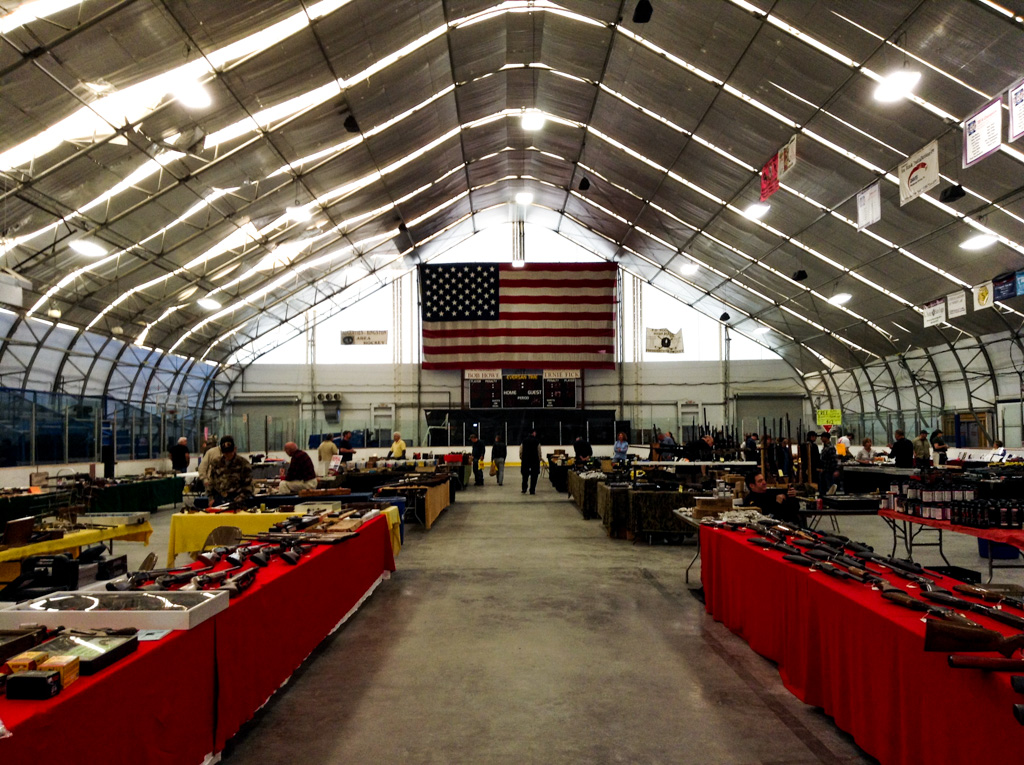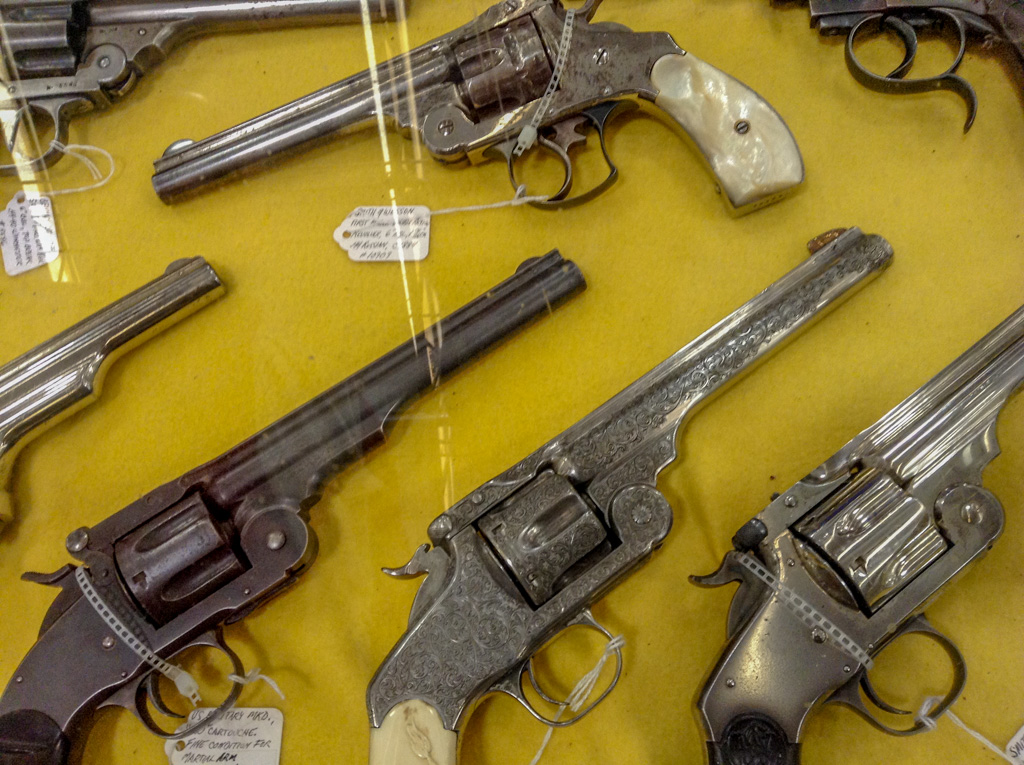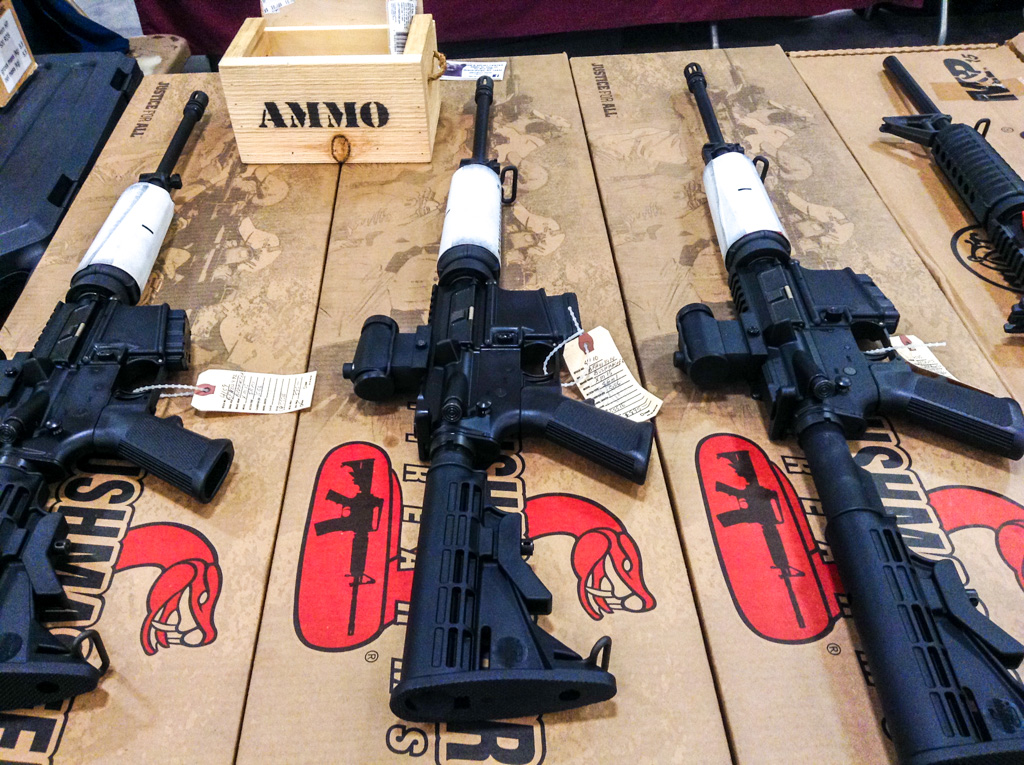Gun Sellers
A Life on "The Hunt"
The parking lot in front of the Kiwanis Ice Arena in the small town of Saugerties, New York, was almost full on a sweltering April day. The smell of hot dogs and sauerkraut from inside a small kitchen filled the reception room. A “Big Buck Hunter Pro” arcade machine hummed in the corner.
Past the “Skates and rentals straight ahead” sign, men and women inside the rink came into view, standing over rows of display tables. Standing next to his wife, Cathy—she was in charge of taking the $8 entry fee in exchange for a green entry stamp—David Petronis surveyed an arms fair in full flow. The people who sat at the tables are gun sellers and this, in arms dealer parlance, is part of the hunt.
“I don’t hunt for animals anymore because I’ve got no desire to shoot ‘em,” said Petronis. “My hunting is a for a rare find that I can enjoy digging up and perhaps keeping or making a lot of money on it. The hunt is very nice.”
Petronis, who has organized gun shows for three decades, including this one, has his own stall selling the wares of the Hudson River Trading Company—mostly antique rifles and an assortment of handguns, knives, and other military artifacts. He’s well known on the circuit as an advocate for New York’s gun owners and dealers. “Up here they call me the face of the gun business,” he said, “because I’m on TV so much.”
Across New York and beyond its state lines, the gun sellers, mainly men, ply their trade at shows like this one almost all year round. Spending weekends on the road is a sacrifice that helps keep their businesses afloat. Some of the people at the Saugerties event run gun shops; others buy and sell collectables ad-hoc for a bit of extra income. The shows are the pinnacle of their hunt—selling the weapons they have carefully sourced and looking out for rare finds.
The language of the gun seller is highly technical. How do you know if you have “scratched stock” and what is the difference between a Remington Model 7 and a Model 94 Winchester? This is an old and changing business, constantly shaped by the political environment and the gun laws that constantly evolve. Some of the sellers have gotten to know each other for years, and have become good friends. The Petronises attend every gun show together and work side by side for the New Eastcoast Collectors Associates events they run. Mr. Petronis, who wore a beige outdoors waistcoat jacket, said he called this event an “Arms Fair,” after the old shows that used to run in the U.K. The term is more mellow sounding, he said.

In rural and mountainous upstate New York, there are ample opportunities for the hunt. In the Adirondacks and the Catskills, hunting, gun clubs, and shooting ranges are a big part of local culture and tourism. Gun enthusiasts follow the sellers. “I wouldn’t use the term ‘groupies,’ like they follow an entertainer,” said Petronis, “but there certainly are people who do follow the gun shows.”
Opposite the Petronises’ stand, James Masten sat behind rifles that stood upright with their barrels pointed towards the ceiling and several weapons laid out on top of two covered tables. Old Winchesters are his guns of choice. His white beard has earned him the nicknames Santa and Papa Smurf.
The money Masten makes from gun shows is recycled into his property preservation business and to fund his retirement. He’s made good friends with a small group of New York dealers and the camaraderie softens the often-long distances he has to travel to each show from his home in North Creek. The next show was to be in Hamburg, a four and a half hour drive away.
Occasionally, Masten stays in a camper van with two fellow sellers, Tim Douglas and Joe Albano. They meet on the Friday night before the show, have dinner, and wile away the evening watching television, telling stories, or playing cards. The sellers become friends and “like a family,” said Albano, who is of medium height and tanned. He runs Joe’s Sports Center and works with Douglas.
By their stall, a man held up a black semi-automatic weapon, one eye closed, with his arm extended and the butt resting on his shoulder. The AR is a big seller for Albano and Douglas, who also sell hunting rifles and shotguns. It’s not a gun they used to sell; it is primarily bought for self-protection, although Douglas, a bear of a man wearing a black T-shirt, says he uses it to shoot coyotes on his farm. The AR has courted controversy in the region since a similar model was used in the Newtown shooting in neighboring Connecticut. Andrew Cuomo, the New York Governor, has banned several of its features.
But that seems to have only spurred sales. “The change in the laws have made people panic buy,” said Albano.
Politics shapes this industry, and all the sellers keenly feel this. Earlier in the year, CNN ran a headline that touted Barack Obama as America’s best gun salesman. Obama’s calls for more gun control in the wake of the San Bernardino shooting caused sales in some gun shops to skyrocket, according to the CNN report. The same is likely to happen in August and September if the Democratic nominee, likely to be Hillary Clinton, is winning in the election polls, said Douglas. “They think she’ll take away their guns,” he said.
The room is divided into tables selling the older hunting and sporting-style rifles and the newer, “black irons”—cheaper and more mass-produced. The customers are similarly divided. “You don’t see a lot of guys that like the ARs and then the Winchesters. It’s why some guys drive Priuses and some drive Cadillacs,” said Masten.
A man in an NRA hat inspected boxes of bullets stacked on top of each other, lined up on the stall of Freedom Cartridge, where Jeffrey Herron sells to hunters, sporting shooters, and everything else in between, he said. Herron picked up a bullet—the size of an adult thumb—for a .50-caliber rifle. The man in the hat sidled into the conversation and muttered under his breath about how he had been unable to buy a slingshot recently. “But I can buy a .50-caliber,” he said. “The New York laws are ridiculous.”
Politics were on display at the arms fair, too. Along the aisles, Cathy Sorrentino is sat behind a sign that read, “We need more Syrian refugees like the Iran nuclear deal.” A man opposite her wore a T-shirt that declared “Hillary for Prison.” This was a Trump room, she said. Along with selling Trump paraphernalia, her husband specialized in concealed handgun equipment. He is known as Firearm Pop. The pair also sells gun-shaped dog biscuits. A giant U.S. flag was draped against the back wall underneath the rink’s dome roof.
A man called Wolfie reclined in his chair wearing a hat with a feather in it, a hat he said he bought in Iowa thirty years ago: “I feel naked without it.” A graduate in oceanography from New York University, Wolfie, real name Theodore Handel, is a relative latecomer to the gun fair scene. His Asperger’s syndrome, he said, fueled his obsession for collecting things. “I usually don’t make any money because the hunt is more important to me,” he said.
His Asperger’s is part of the reason he has such an extensive knowledge of the knives, revolvers, and crossbows on display. He took several minutes to explain the development of the crossbow from the soldiers’ longbow into today’s modern style bow.
The Saturday event at Saugerties was, by all accounts, a slow one for business. Petronis, as organizer, said he doesn’t have as much fun at these events as he used to. And he fears that the number of people who have an interest in the collectable weapons that he sells has receded, and interest in the ‘black irons’ is gaining. So the future is uncertain. “We could be a dying breed,” he said. “I don’t know how many people are coming to replace us old folkies.”

The Impact
One Shoe At A Time: A Mother Turns Pain Into Purpose
An Unsolved Shooting Baffles a Mom for Two Decades
How Grief and Anger Turned Into Action
Silver Gun: A Robbery in Queens
Shooter: “It’s Either Them or Me”
After a Single Dad is Shot, a Community Reels
